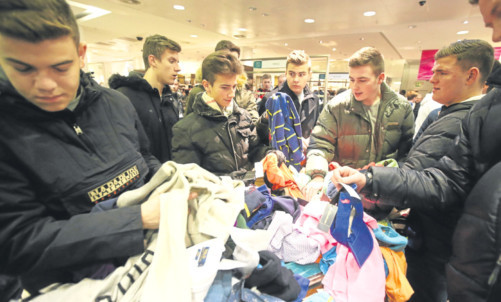
Earlier starts and internet change our habits.
It was once the traditional way to begin the New Year, but it’s now becoming a thing of the past.
No, not black bun, dressed herring or lumps of coal we’re talking about elbowing fellow shoppers in the ribs and trampling over fallen bargain hunters in the January sales.
It seems the battle for a bargain after New Year is dying a death, and it’s all thanks to early sales and the internet.
Astonishingly, not a single major high street retailer now begins their sale in January. In fact, most companies started their own online offers before Christmas.
Debenhams, for example, officially started its sale with limited 50% off online from Christmas Eve and in store from Boxing Day, rising to 70% later. Amazon started its Boxing Day sale at 4pm on Christmas Day and had up to 70% off from Boxing Day.
According to new figures, savvy shoppers aren’t waiting until the wrapping paper has been cleared away before logging on for a deal, with record numbers buying online on Christmas Day.
The figures, published yesterday, confirmed a big jump in online spending on December 25 compared with last year. Experian Hitwise analytics recorded 147 million visits to retail websites on Thursday, up from 110 million on Christmas Day 2013.
The experiment of launching early online sales started last year. Many retailers have adopted the same strategy this year to get rid of vast quantities of unsold stock, with the January sales extended well into February.
Stores across the country reported huge numbers of customers through their doors on Boxing Day and yesterday, with an estimated 20 million Brits spending a record £2.9bn on December 26 up £200m on the previous year. However, while spending may have gone up, the number of people out shopping yesterday was actually down on last year.
Diane Wehrle, of retail intelligence firm Springboard, said the drop in numbers of shoppers could be down to the growing popularity of early December sales.
She said: “I think a lot of people bought a lot of what they wanted on Black Friday.”
However, Gary Turnbull, the general manager at Glasgow’s Braehead shopping centre, said: “We were very busy yesterday and shoppers seem to be getting their second wind. We’re expecting more today.”
The Retail Traffic Index the national barometer of retail footfall used by analyst firm Ipsos Retail Performance said Boxing Day footfall was down 4.7% for the day compared with 2013.
Stores on high streets and retail parks suffered the most, with traffic levels down 7.1% and 7.2% respectively.
Tim Denison, from Ipsos, said: “Last year, Christmas Day started sapping the pull of Boxing Day as retailers experimented with launching sales online on the 25th, which proved amazingly popular.”

Enjoy the convenience of having The Sunday Post delivered as a digital ePaper straight to your smartphone, tablet or computer.
Subscribe for only £5.49 a month and enjoy all the benefits of the printed paper as a digital replica.
Subscribe